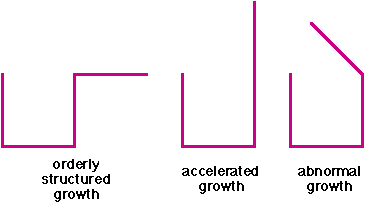|

Chaos
Abstract
The following discussions and activities are designed to lead the
students to explore various
incarnations of chaos.
Objectives
Upon completion of this lesson, students will:
- have experimented with several chaotic simulations
- have built a working definition of chaos
- have reinforced their knowledge of basic probability and percents
Standards
The activities and discussions in this lesson address the following
NCTM standards:
Number and Operations
Understand numbers, ways of representing numbers, relationships among numbers, and number systems
- work flexibly with fractions, decimals, and percents to solve problems
Data Analysis and Probability
Understand and apply basic concepts of probability
- use proportionality and a basic understanding of probability to make and test conjectures about the results of experiments and simulations
- compute probabilities for simple compound events, using such methods as organized lists, tree diagrams, and area models
Links to other standards.
Student Prerequisites
- Geometric: Students must be able to:
- recognize and sketch objects such as lines, rectangles,
triangles, squares
- Arithmetic: Students must be able to:
- understand and manipulate basic probabilities
- understand and manipulate percents
- Technological: Students must be able to:
- perform basic mouse manipulations such as point,
click and drag
- use a browser such as Netscape for experimenting with
the activities
Teacher Preparation
Students will need:
- Access to a browser
- Pencil and calculator
- Copies of supplemental materials for the activities:
Key Terms
This lesson introduces students to the following terms through the included discussions:
Lesson Outline
This lesson is best implemented with students working in teams of 2,
alternating being the "driver" and the "recorder."
Allow the students about 30 minutes to explore each computer activity.
- Focus and Review
Remind students what has been learned in previous lessons that will be pertinent to this lesson and/or
have them begin to think about the words and ideas of this lesson:
- Does anyone know what predictabilty means?
- Can anyone explain what chaos means?
- If I lit a fire in the middle of the room can anyone predict what else would catch on fire?
- What would influence the way the fire might spread?
- Objectives
Let the students know what it is they will be doing and learning today. Say something like
this:
- Today, class, we are going to learn about probability and chaos.
- We are going to use the computers to learn about probability and chaos, but please do not turn your
computers on until I ask you to. I want to show you a little about this activity first.
- Teacher Input
- Lead a class discussion on basic probability
to prepare students for working with the activities.
- Guided Practice
- Have the students try the computer version of the
Fire! activity
to investigate how large the burn probability can be and still
consistently have trees left standing.
- Lead a class discussion on chaos.
- Ask the class to think about why the fire activity is not very realistic.
Be sure the point that controlling the probability of the spread of the
fire is out of a person's hands. Motivate the next activity by pointing out
that if we assume that fire will spread 100% of the time, then leaving some
empty space in the forest (which a person can control) may keep the
entire forest from burning.
- Have the students try the computer version of the
Better Fire! activity
to investigate how large the forest density can be and still
consistently have trees left standing after a fire.
- Lead a class discussion on how prevalent chaos
is in science.
- Independent Practice
- Have the students try the computer version of the
Game of Life activity
to investigate this classic demonstration of chaos.
- Have the students try the computer version of the
Rabbits and Wolves activity
to investigate how the effects of small changes in the initial values of
things changes the outcomes.
- If you choose to hand out the accompanying worksheets you can have
the students complete them now.
- Closure
- You may wish to bring the class back together for a discussion of the findings.
Once the students have been allowed to share what they found, summarize the results of
the lesson.
Alternate Outlines
This lesson can be rearranged in several ways.
Suggested Follow-Up
After these discussions and activities, the students will have seen more ways in which chaos, first introduced in the Fractals and the Chaos Game lesson, is used to model behavior. The next lesson, Pascal's Triangle, reintroduces Sierpinski-like Triangles, as seen in the Geometric Fractals and
Fractals and the Chaos Game lessons, in yet another way, demonstrating the rich connections between seemingly different kinds of math.
|

